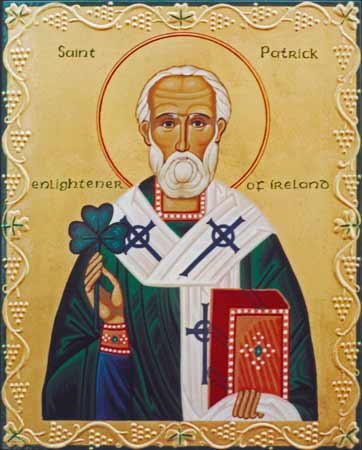the Apostle of Ireland (†493)

| Orthodox Outlet for Dogmatic Enquiries | Biographies |
|---|
|
The Holy Hierarch Patrick, the Apostle of Ireland (†493)
|
 |
A first approach to the indigenous Orthodox Saints and Martyrs of the Ancient Church who lived and who propagated the Faith in the British Isles and Ireland during the first millennium of Christianity and prior to the Great Schism is being attempted in our website in our desire to inform our readers, who may not be aware of the history, the labours or the martyrdom of this host of Orthodox Saints of the original One, Holy, Catholic and Apostolic Church of our Lord.
"The Church in The British Isles will only begin to grow when she begins to venerate her own Saints" (Saint Arsenios of Paros †1877)
|
SAINT PATRICK (Latin: Patricius, Irish: Naomh Pádraig) was a Celtic Briton and Christian missionary, who is the most generally recognised patron saint of Ireland (although Brigid of Kildare and Columba are also formally patron saints).was a Romano-Briton by birth. He was probably born in 390 on what is now the north-west coast of England at an unidentified place called Bannavem Taburniae. The son of a town councillor, his grandfather had been a priest. Bearing the Roman name ‘Patricius’, meaning ‘noble’, he was brought up to speak Latin but paid no attention to the teachings of Christianity. When he was about fifteen years old, he was captured by Irish pirates and reduced to slavery to tend herds for six years. As a shepherd boy, he often came to pray and so know God. After these six years, he was told in a dream that he was to return to his own land. He either escaped or was freed and eventually managed to return to his family. Here he received training for the priesthood and travelled to monasteries in Gaul, where he stayed for some time. They may have included the monastery of Lerins in the south of France, where there was a famous monastery founded under the influence of the great Egyptian monks like St Anthony the Great. In about 435, Patrick returned to Ireland from Gaul as a Bishop. He set up his See in the north of Ireland at Armagh and encouraged the monastic life there. He also set up a school in Armagh and from there made many missionary journeys, preaching, teaching, baptising and building churches and monasteries. Bishop Patrick has left us writings that have survived to this day. There exists his Confession, or autobiography, a letter condemning slavery and also his remarkable 'Breastplate', in which he confesses his utter faith in Christ. It is clear that Patrick was extremely humble and devoted to Christ; he was an extraordinary shepherd of souls. Tradition relates that he expelled all demons and snakes from Ireland. To this day, there are no poisonous snakes to be found in Ireland.
He also taught of the mystery of the Oneness and Threeness of the Holy Trinity using shamrock, a local plant whose leaves are formed of three parts and yet are one. Much revered, he reposed in the Lord about 461. Today St Patrick is the patron saint of Ireland. He is the most popular of all the Irish saints as he is considered to be responsible for the successful introduction of Christianity to Ireland. Several places are connected with him in Ireland, such as Armagh, Downpatrick, Croagh Patrick and Saul, although the whereabouts of his relics is now unknown. There was also much devotion to him from early times not only in Ireland but also on the south-west coast of Wales and the north-west coast of England, for example at Heysham. St Patrick's feast is kept on 17 March.
|
Article published in English on: 7-8-2009.
Last update: 7-8-2009.